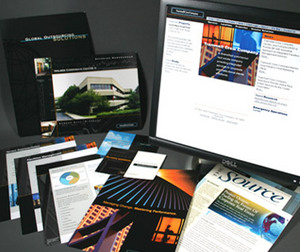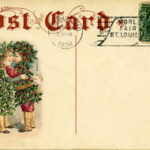With all the technology that is available today, small business owners can create a professional marketing image without spending all their money. The way to accomplish this is by creating a professional corporate identity.
A corporate identity consists of three elements:
* Company name
* Company logo
* Unique selling position or tagline
Your corporate identity communicates to the world that you mean business. It appears on everything that leaves your business, including business cards, letterhead and envelopes, note cards, postcards, brochures, web site, advertising, and more.
Everything you do to market your business should stem from your corporate identity. This is referred to as “branding” your company, product or service.
Think about popular products you use. For many, soft drinks come to mind. Everyone knows who owns the red and white can. It’s a common household name. So, how do you create a corporate image that makes people remember your business?
The first thing to do is give serious consideration to the impression you want people to have of your company. Your corporate identity is the visual interpretation of the value you offer to your customers. To achieve this visual interpretation, most organizations use a logo. A logo is a professional graphic that provides a powerful and memorable image of what it stands for.
The majority of business owners are not adept at graphic design. If you want a logo that leaves a lasting impression, it’s probably best to have a professional design it for you.
When designing your company logo, keep the following tips in mind:
Conduct research. Visit your competitors’ web sites and look at their logo designs. Do their logos connect with their company, product or service? Are the colors pleasing to the eye? Do they have a unique selling position or slogan? Print a copy of logos that you are attracted to and place them in a file.
Determine the use of your logo. Will your logo be used to identify your company, service, or product? This is a big decision, so weigh your options carefully. Once people begin connecting with your logo it is difficult and expensive to go back and change everything.
Determine the look. Will your logo be your company name, an icon, or graphic? Perhaps you will want to include both elements. Marketing experts recommend that you avoid the use of a stand-alone icon until you are a well-established business. When you are starting out it is best to use a graphic and your company name. Make sure your company name is clear and visible within your logo. If your potential customers aren’t able to read your name, how can they get in touch with you?
Avoid clipart: While it can be tempting to use clipart to create your logo, it’s a really bad idea. It makes you look cheap and unprofessional. If you can’t design your own logo, hire a professional.
Design in black and white. When you create your logo it’s best to create it in black and white. You can easily translate the design into color when you are ready to go to print. Using black and white helps you to focus on the typeface, shape and design. You’ll be able to see if your logo is clear and legible if it is photocopied or faxed.
Choose two colors. When designing your logo, keep the color scheme limited to two colors. This is the most cost effective way to print. The more colors you have, the more expensive it becomes. This is important to remember if you plan on advertising in print media.
Choose the typeface. You should not use more than two typefaces or fonts. The most traditional and common font used is ‘Old English’. For a more modern look use ‘Avant Garde’ or ‘Optima’.
Consider the size. Your logo must be legible in a variety of sizes. You can test this by shrinking it to the smallest, and enlarging it to the biggest possible usage size. Think of all the places you will be using your logo and the sizes that correspond to those usages. For instance, if you were to attend a trade show and require posters for your booth, you would want to make sure your logo would work well in that situation. If you’re going to include it on mailing labels, you want to be sure it is legible in a smaller size.
Experiment. After you have obtained the design and color scheme, try it out on a variety of materials and mediums you intend to use it on. Create a piece of letterhead. Put it on different size envelopes. Place it on a business card or brochure. If you intend to use a magnetic sign on your car or van, take a digital photo of your vehicle; download it to your computer, than paste your logo on the door to see how it will look.
Take time to reflect. Once you’ve decided on your logo, put it away for one week. If, after that time, you are certain this is the logo you want, than proceed forward. Make certain to check for typos and recheck your design for flaws or imperfections.
Creating Your Marketing Materials
Now that you have the perfect logo, it’s time to show it off to the world. Your business card speaks volumes about you and your business. Take time to create a card that will leave a positive and lasting impression.
While it may be tempting to print your business cards at home, it’s not recommended. You’ve probably seen the business cards that you can tear off. There are generally ten to a sheet and you run them through your printer. No matter how hard you try, you will never be able to obtain a smooth finish on the edges.
There are many affordable printing services available online. Check with your local printer to obtain a pricing sheet. Many print shops offer 500 business cards on high-quality stock for around $20.
Think of your business card as a mini-brochure. You can easily include additional information about your business for a minimal cost when you print on both sides of the card. Many people neglect to use this prime piece of real estate. Utilize it for maximum exposure. Your business card should include:
* Your corporate identity – company name, logo, unique selling position or slogan.
* Your mailing address
* Your email address
* Your web site URL
* Your business phone and fax numbers
* A list of your products or services
Note: Many home-based business owners opt for a P.O. Box to avoid publicizing their personal information. P.O. boxes are generally available for less than $100 per year.
Company Brochure
A company brochure may or may not be a good idea. For most, it’s a great idea. But for some home-based businesses, a marketing or media kit may be more appropriate. We’ll talk more about that in a moment.
If you decide that a printed brochure is a good option for you, the key to success is leveraging its use. You want to choose a format that allows you to use the piece in a variety of ways. For instance, you could use the brochure as a direct mail piece and also take it with you on sales calls and to trade shows. When creating your layout, reserve one panel as a self-mailer, so you can expand your opportunities for using the brochure. Your corporate brochures should include:
* Corporate identity – company name, logo, unique selling position or slogan.
* Company guarantee – do you offer a satisfaction or money-back guarantee? People feel better about working with a company that stands by their product or service. Make your guarantee better than your competitors.
* Company information – products and services offered, hours of operation, contact information and company background.
The layout of your brochure is just as important as the information it provides. Keep it consistent with your corporate identity. Use compelling content that engages readers. Make it easy-to-read and be certain that it has a good flow to it. On the final panel, provide a clear call to action. Tell the readers exactly what you want them to do after reading the brochure.
Other Marketing Materials
There are many marketing material options available. The following are just a few examples:
* Postcards – perfect for announcing a new business, special offer or sale
* Data sheets – allow for a greater level of detail about your products or services
* Newsletter – this can be provided electronically or in print
* Gift certificates or discount coupons
* Promotional items – magnets, rulers, tee shirts, hats, pens, pencils, etc.
* Magnetic signs – attach to your vehicle to promote your business while driving
Creating a Media Kit
A media kit is used to attract the attention of newspapers, radio, or other media. It can be used as part of a marketing campaign or to announce happenings and events that your business is involved with. Common uses of a media kit include:
* Announcement of a new business
* Announcement of a new office location
* Announcement of a new partnership
* Announcement of company involvement in a charity event
A media kit should be consistent with your corporate identity and include the following:
* Cover letter
* Company brochure
* Business cards
* Press release
* Mission statement and company background
* Biographies and credentials of key personnel
This information should be presented in high-quality presentation folders, which can be purchased at an office supply store. Presentation folders are available in a variety of colors and designs. Choose the design that best represents the message you want to convey about your company, service or product. Customize the folder by attaching a label on the front that includes your company logo.
A media kit supplies media personnel with information they need to write a story or conduct an interview about you and your company. Your primary goal should be to ensure that your media kit makes the media person’s job easier. They should be able to find all the important and necessary information within the kit.
Media people are inundated with materials so you want to make yours stand out from the rest by presenting it in the most professional manner possible. Do your research and make certain your media kit appeals to the audience to which you are sending it. An attractive, professional and informative media kit will help you get the attention you desire and deserve, so take the time to make certain it is perfect.



